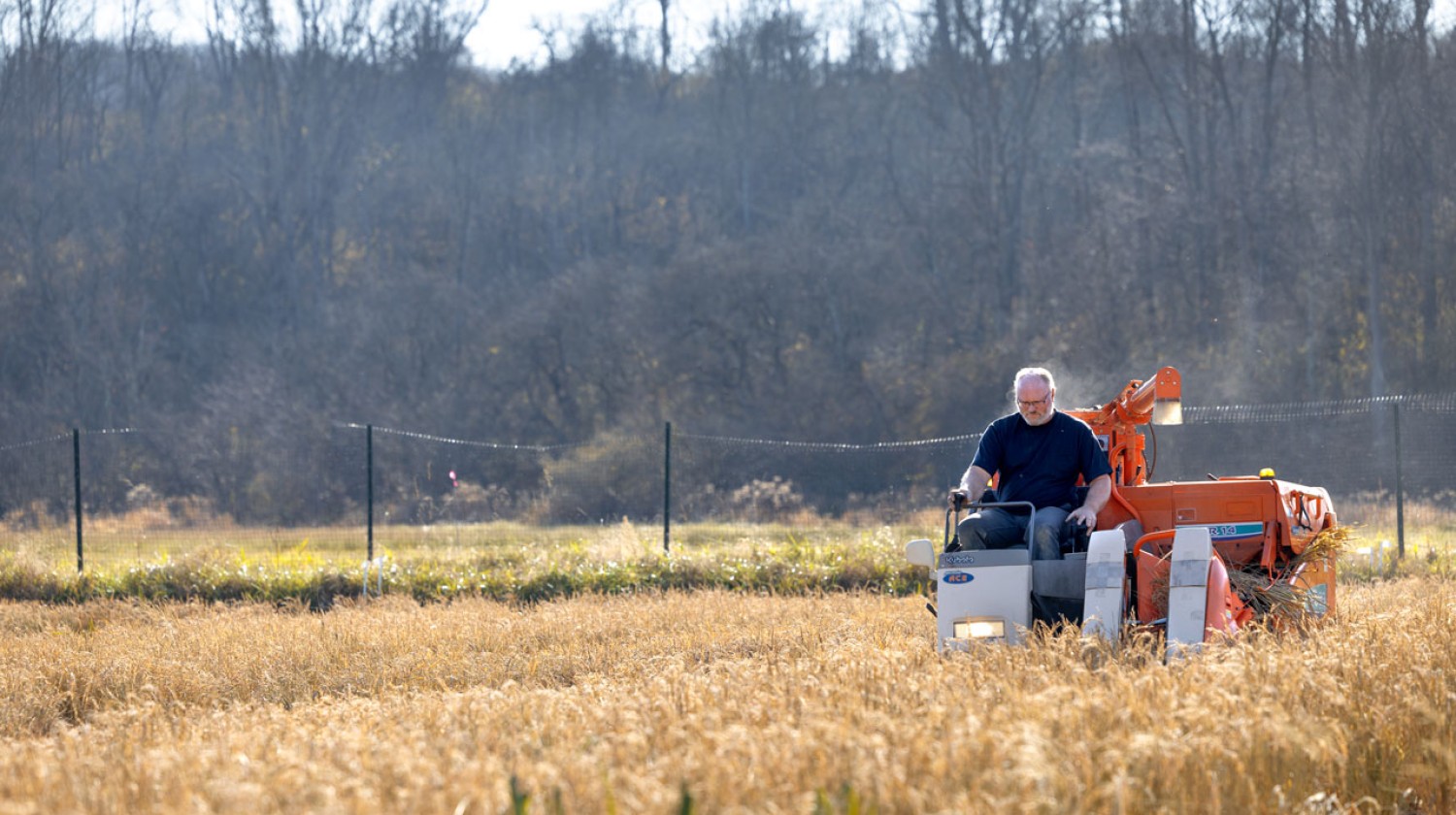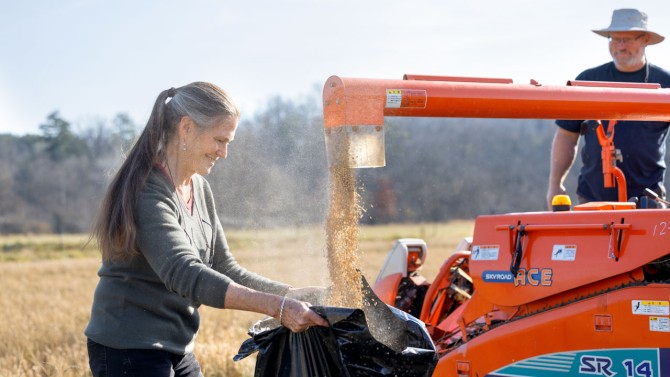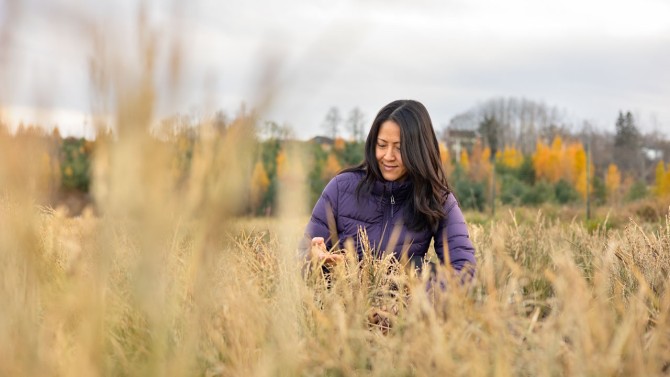Cornell Cooperative Extension is helping New York state farmers learn how to grow rice, a potentially lucrative crop that can thrive on flood-prone land as a hedge against climate change.
Rice can help NYS farms profit from climate-change flooding
By Susan Kelley, Cornell Chronicle
Rice geneticist Susan McCouch caught a waterfall of rice pouring from the hopper of a harvester combine idling in a drained rice paddy about 10 miles from campus and grabbed a handful to take a closer look.
It was the first harvest of a new Cornell project to help New York state farmers learn how to grow rice. The potentially lucrative crop can be grown on land that is flood-prone, and in dry conditions, as a hedge against climate change.
“The grains are looking quite good right here – they’re not discolored, they’re healthy,” said McCouch, Ph.D. ’90, professor in the School of Integrative Plant Science (SIPS), Plant Breeding and Genetics Section, in the College of Agriculture and Life Sciences (CALS). “I think we just go ahead and dry them down and see how they cook up. It looks great.”
She is part of a team lead by Cornell Cooperative Extension that is growing rice on two demonstration plots: in a flooded rice paddy in Freeville, New York, and in dry conditions in Candor, New York, in Tioga County. The project will also include online “how to” growing guides, and research to identify areas in the Northeast that are suitable for rice and surveys to understand farmers’ willingness and barriers to growing it. The team will also investigate how rice-growing provides habitat for birds, storm water and pollution mitigation, and more.
“This is the right time, in terms of flood-risk issues and the need for diversified farming practices in New York state and across the Northeast,” said Jenny Kao-Kniffin, the CALS associate director of Cornell Cooperative Extension.
Climate change has increased the severity and frequency of rain and flooding in the Northeast, and New York farmers, especially small growers, are facing escalating risks of flooding on their land. Too much water threatens high-value crops like vegetables and fruit, said Kao-Kniffin, an associate professor in SIPS’ Horticulture Section. “It just takes 48 hours of flooding or so, and the harvest could be gone, especially if it brings in inches of silt.”
Many farmers have responded by transitioning away from high-value crops and instead plant other crops like hay in flood-prone areas. Or they’re just letting that land go fallow.
But rice can provide a lucrative alternative.
Erik Andrus nets $12,000 per acre of rice on his Boundbrook Farm in Vergennes, Vermont, in the Champlain Valley. “Comparatively, with a good corn crop, a farmer might make between $350 and $800 per acre in profit off it,” said Andrus, a consultant on the project. He sells brown rice for $6.50 per pound – about $7.50 for white rice – to customers including the high-end restaurant Blue Hill at Stone Barns in Tarrytown, New York. Other rice farms in the Northeast market their product for as much as $10 to $15 per pound. “It’s intensive though,” Andrus said. “You have to be able to do the work.”
Would-be New York rice farmers need assistance to learn how to do it right, said Luke Gianforte ’14 of Gianforte Farm in Cazenovia, New York. They have been farming rice as an experiment on 2.5 acres since 2012, with the guidance of Gen Fumio Onishi, a rice farmer and a now-retired member of the McCouch lab. Rice is an add-on to the other organic food-grade grains the Gianforte Farm grows, including corn, soybeans, wheat, oats and triticale. “It was very wet ground to start with. We weren’t growing any other crops there,” Gianforte said. “So rice gave us an option.”
But they could still use the kind of assistance the project provides, he said. “This year, we had decent success. But you know, last year was a complete failure,” he said. “By no means do we have it figured out.”
The two CCE demonstration plots replicate the scenarios facing New York farmers. The rice paddy in Freeville, at Cornell’s Homer C. Thompson Vegetable Research Farm, was decommissioned from vegetable production 15 years ago due to flooding from the adjacent Fall Creek.
But rice doesn’t need flooding to grow. “It’s the only major crop that can actually take oxygen from the air and send it down through its stems to its roots in waterlogged soil,” said McCouch. The reason rice paddies are flooded is to suppress weeds, she said. “Most plants can’t really grow well in anaerobic (waterlogged) soils.”
Rice will also grow in dry conditions, as it did in demonstration plots at CCE Tioga County’s Hilltop Community Farm in Candor. “Rice can be grown in raised beds covered with plastic mulch to hold water and suppress weeds – I call it growing rice as a vegetable – and that’s much easier if you have the infrastructure to do it,” McCouch said.
The team planted rice varieties that grow in cold climates, such as northern Japan, Korea, Ukraine, Russia and Chile. “We are growing varieties that are grown on the edge, the absolute edge” of rice’s growing range, as rice is tropical in origin, McCouch said.
CCE enlisted Andrus to provide expertise and teach CCE staff how to grow rice at the demonstration sites.
“I have believed from the get-go that this is one of these areas of agriculture where we need a community and we need sharing of information,” he said. “We on our farm have had to master so many domains that we really didn’t choose for ourselves, but we had to do them in order to make the rice project advance. I needed to figure out how to do field engineering and hydrology analysis and irrigation planning.”
Some farmers feel there’s too much to learn to grow rice. But the CCE project can help change that, Andrus said.
“People can witness this, and then imagine themselves doing it,” he said. “This is a really important step, to have demonstrations where, warts and all, we can show people how we’re getting production done.”

Erik Andrus, a CCE consultant and rice farmer, drives a Kubota Skyroad Ace 214 combine harvester through a drained rice paddy at the Homer C. Thompson Vegetable Research Farm in Freeville, New York.
Expanding the scope of rice farming
Andrus climbed up on a Kubota Skyroad Ace 214 combine harvester, started the engine, put it into gear and slowly drove through the drained rice paddy in Freeville. Its crawler tracks, like those on a tank, enabled it to move along the soft ground without sinking. The machine grasps the upright stalks, cuts them and turns them horizontally onto a conveyor belt that feeds them into a threshing chamber. It beats the grain off the stalks and into a collection box, as the combine leaves a brush-cut of stalks in its wake.
CCE imported the harvester, as well as a planter, dryer, dehuller and a polisher, with Andrus’ help to demonstrate the kinds of equipment farmers need and how to run and maintain them. The machines, imported from Japan, are available second-hand at low prices and are designed to operate on small parcels of land – like most New York farmers have. “Without the right tools, and without some idea of how to use and maintain them, it’s really difficult,” Andrus said.
Identifying where in NYS rice can be grown will be just as important, the researchers say.
That’s the aim of Chuan Liao, M.S. ’12, Ph.D. ’15, assistant professor of global development (CALS), who specializes in the relationship between the environment and development, and Wendong Zhang, assistant professor and extension economist at the Charles H. Dyson School of Applied Economics and Management in the SC Johnson College of Business and CALS.
They’ll assess maps that show flood risk, topography, existing land use and more to identify the areas that are best suited to rice. “We’ll focus on agricultural flood plains, instead of converting natural areas or wetlands into agriculture,” said Liao, who grew up eating rice every day in his native China.
And they’ll survey farmers who grow rice, as well as farmers who do not but have flooded fields, to understand their motivations and the barriers that would prevent them from growing rice. They’ll also leverage these partnerships for seed production and rice processing, promoting broader adoption in the Northeast.
“We don’t imagine this will be an overnight transition, because farmers would dedicate a small patch of their land to try rice first and see if that works, and gradually expand the scope of rice farming,” Liao said. “So the transition will take some time.”

A red-necked phalarope swims in a CCE rice paddy in Freeville, New York. It was only the second time a phalarope had been seen in Tompkins County away from Cayuga Lake.
Benefits for shore birds and the local economy
Paul Herwood, a birder from Ithaca, stood at the edge of the Freeville test plot, his Nikon D500 with a 500 millimeter PF lens at the ready, on the chance a Yellow Rail, a tiny marsh bird that lives its life concealed by grassy vegetation, would be flushed during the harvesting.
He and his son, Tristan Herwood ’22, a software engineer at the Lab of Ornithology’s Macaulay Library, have also sighted two rare red-necked phalarope, a tiny grayish bird with a needle-thin bill that breeds in the Arctic. It was only the second time phalarope had been seen in Tompkins County away from Cayuga Lake. About a month later, Paul Herwood spotted a long-billed dowitcher, only the fourth ever recorded in the county.
They’ve identified 11 species of shore birds at the paddy, including greater and lesser yellowlegs, Wilson’s snipe and five different kinds of sandpiper. “And that’s not even monitoring this 24/7,” he said. “Tristan and I are hoping the extent of the rice paddy will be expanded at this location and symbiotically provide meaningful surrogate stopover habitat in Tompkins County for migrating shorebirds.”
The United States Shorebird Conservation Plan advocates for rice agriculture, which, if appropriately managed, can provide important habitat for migrating shorebirds, he said.
The researchers will evaluate how rice can provide those and other environmental benefits, from carbon storage and stormwater water retention to mitigation of fertilizer pollution. “If a rice paddy is in a place that receives water with high levels of phosphorus or nitrogen, such as from dairy farms, it could be designed as a buffer that would minimize polluted runoff getting into nearby lakes and streams,” Kao-Kniffin said.
In time, the environmental and economic benefits could extend throughout the region, McCouch said.
For example, she envisions a sake – rice wine – industry for the Finger Lakes, with sake made from locally grown short grain rice. Several downstate sake distilleries are looking for New York sources of the grain, she said.
“It would be very interesting to have rice paddies along the Finger Lakes, near the distilleries, with sake as an option,” McCouch said. “It would show people a little bit more about how water is managed and how this crop can be integrated, utilizing land that cannot be used for other crops.”
Media Contact
Get Cornell news delivered right to your inbox.
Subscribe



